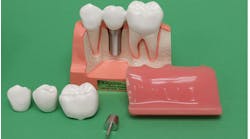We often hear from prospective sellers, “How much more can you really improve my offer? Why would I pay someone to negotiate on my behalf if I already have a deal in front of me that I’m happy with?” In truth, most of our job isn’t to ensure you get a valuation that you’re happy with. It’s to ensure the valuation you receive holds up, and that you’re protected from the other trapdoors built into letters of intent (LOIs) that will impact your value down the road. Unfortunately, you might not fully understand what your offer really entails until it’s too late.
More by this author:
- Hello! May I buy your dental practice?
- I'll buy your business for 25x EBITDA
- 2023 market update: Finding the rhythm
Here’s a pretty standard offer you might look at from a DSO:
- DSO-determined earnings before interest, taxes, depreciation, and amortization (EBITDA) = $850k on $3.5MM in revenue
- Valuation is an 8X = $6.8MM enterprise value or 194% of collections
- Allocation = 65% cash ($4.42MM) // 25% joint venture equity ($1.7MM) // 10% holding company equity ($680k)
In the above example, the seller was thrilled with the valuation and ecstatic to sign the LOI. A few months after signing, they came to us because the deal had blown up in due diligence, and they were confused, tired, and upset about the entire process.
At face value, the outlined deal looks great. But buried deep into every LOI are deal terms, background information, and legal language that need to be reviewed and negotiated for the deal to move forward. Deals often change dramatically from LOI to final documentation, and doctors are left with the unenviable decision between agreeing to the changes or walking away from a process they’ve invested six-plus months into.
Here are some areas that are overlooked when perusing an LOI:
EBITDA
This baseline valuation metric is at the core of all private equity (PE)/DSO/venture capitalist (VC) offers. As a measure of profitability, it informs buyers of how long it will take to begin receiving a return on their investment. During closing, you’ll go through a “quality of earnings” process, which is a third-party analysis of your EBITDA. If it comes up negative, the value of the deal will generally be reduced. If it comes up positive, in a DIY deal, you’ll rarely receive feedback that it did. In a represented sale, we’ll help determine your EBITDA based upon the same accounting mechanisms that a quality of earnings firm would, and then defend that number.
Rollover equity
It is highly likely that between 30% and 45% of your transaction will come in the form of rollover equity. In dental transactions, there are two specific types of rollover equity: joint venture (JV) equity (localized to the practice you’re selling) or holdco equity (specific to the parent entity as a whole). Both can have all kinds of parameters that need to be sorted out to get a full picture of the offer you’re receiving.
Management fees and distributions
This will impact the profitability of the practice and the distributions allocated to your JV equity percentage. However, there are also various clawbacks that are often part of the final asset purchase agreement, related directly to maintenance of EBITDA, growth clauses in earnout computations, and the value of the JV equity. If you’re selling to a management entity, you need to understand how management fees will impact the numbers that you’re paid from.
Private equity
It is critical to understand both the purchasing entity and the organization writing checks to that entity. Where the funds come from matters, and partnering with a group that has a track record of successful exits from their health-care investments affects the future value of your investment in the organization.
These are just a few of the overlooked areas that can make or break deals after signing an LOI. We often also see obstacles with legal language, buyer risk mitigation, and a myriad of other topics. Suffice it to say, there are successful buyers out there who understand exactly what they need out of a transaction to turn a hefty profit. They have a full team behind them helping to bring on deals that check those boxes. You are at a disadvantage if you don’t have the same working behind you!
Editor's note: This article appeared in the September 2023 print edition of Dental Economics magazine. Dentists in North America are eligible for a complimentary print subscription. Sign up here.






